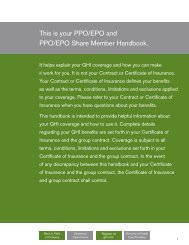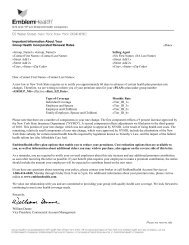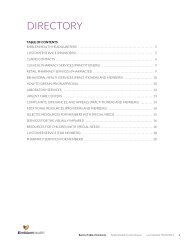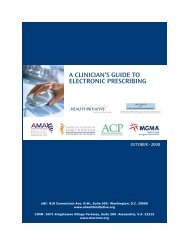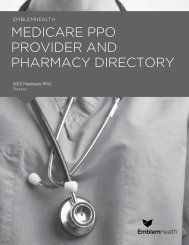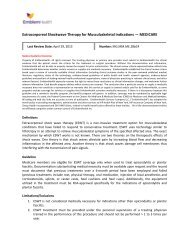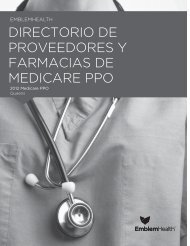PPO II - EmblemHealth
PPO II - EmblemHealth
PPO II - EmblemHealth
Create successful ePaper yourself
Turn your PDF publications into a flip-book with our unique Google optimized e-Paper software.
48 2011 Evidence of Coverage for 2013 HMO Evidence Medicare of Coverage Supplement for <strong>PPO</strong> (cost) <strong>II</strong><br />
Chapter Chapter 4: Medical 3. Using Benefi the ts Chart plan’s (what coverage is covered for your and medical what you services pay)<br />
Part B premium (unless your Part B premium is paid for you by Medicaid or another third<br />
party).<br />
• Your combined maximum out-of-pocket amount is $5,100. Th is is the most you pay during<br />
the calendar year for covered Medicare Part A and Part B services received from both in-network<br />
and out-of-network providers. Th e amounts you pay for copayments and coinsurance for covered<br />
services count toward this combined maximum out-of-pocket amount. (Th e amounts you<br />
pay for your plan premiums and for your Part D prescription drugs do not count toward your<br />
combined maximum out-of-pocket amount. In addition, amounts you pay for some services do<br />
not count toward your combined maximum out-of-pocket amount. Th ese services are marked<br />
as supplemental benefi ts in the Medical Benefi ts Chart.) If you have paid $5,100 for covered<br />
services, you will have 100% coverage and will not have any out-of-pocket costs for the rest of<br />
the year for covered Part A and Part B services. However, you must continue to pay your plan<br />
premium and the Medicare Part B premium (unless your Part B premium is paid for you by<br />
Medicaid or another third party).<br />
Section 1.3 Our plan does not allow providers to “balance bill” you<br />
As a member of our plan, an important protection for you is that you only have to pay your cost-sharing<br />
amount when you get services covered by our plan. We do not allow providers to add additional separate<br />
charges, called “balance billing.” Th is protection (that you never pay more than your cost-sharing<br />
amount) applies even if we pay the provider less than the provider charges for a service and even if there<br />
is a dispute and we don’t pay certain provider charges.<br />
Here is how this protection works.<br />
• If your cost sharing is a copayment (a set amount of dollars, for example, $15.00), then you<br />
pay only that amount for any covered services from a network provider. You will generally have<br />
higher copays when you obtain care from out-of-network providers.<br />
• If your cost sharing is a coinsurance (a percentage of the total charges), then you never pay more<br />
than that percentage. However, your cost depends on which type of provider you see:<br />
� If you obtain covered services from a network provider, you pay the coinsurance<br />
percentage multiplied by the plan’s reimbursement rate (as determined in the contract<br />
between the provider and the plan).<br />
� If you obtain covered services from an out-of-network provider who participates with<br />
Medicare, you pay the coinsurance percentage multiplied by the Medicare payment rate<br />
for participating providers.<br />
� If you obtain covered services from an out-of-network provider who does not participate<br />
with Medicare, then you pay the coinsurance amount multiplied by the Medicare<br />
payment rate for non-participating providers.





